Moodle review: Features, pricing, & recommendations in 2025
28.07.2025 • 10 minutes
Looking for an LMS to build and deliver online courses or training programs?
Moodle is one of the most popular learning management systems trusted by schools, universities, and organizations globally. But is it the right fit for your educational approach in academic or corporate settings?
After diving deep into Moodle and testing it in different teaching and training setups, we’ve put together this hands-on review to help you figure that out.
Overall, Moodle gives you extensive control over how you build and deliver learning experiences. You can set up detailed courses, track each learner’s progress, and customize almost everything to match your style or brand. But does it make things easy for teachers and trainers who aren’t particularly tech-savvy? Is it engaging enough to keep learners motivated without additional tools? And what does it cost once you factor in hosting and support?
This review tackles all of that, including:
- A full look at Moodle’s main features and what you can (and can’t) do with them
- A clear pricing breakdown, whether you’re a small school or a large institution
- What teachers, trainers, and admins say about using Moodle
- Pros and cons we put together while using the software
- And our honest recommendations on who Moodle is best for
Let’s dive in!
You’ll notice a few sections across this review dedicated to how Wooclap integrates with Moodle. This is not to steer you away from our thorough review of the LMS, but to show you how the Wooclap Moodle plugin works, so that in case Moodle ticks all the right boxes, you won’t need to worry about how to enhance its real-time engagement capabilities.
What is Moodle?

Moodle is an open-source LMS launched in 2002 by Martin Dougiamas. It was born from a desire to give educators a flexible platform for creating quality online education experiences. Today, Moodle powers learning for over 444 million users across K-12 schools, universities, nonprofits, and enterprises.
Designed for scalability and customization, Moodle provides the tools institutions need to create rich, personalized learning environments that align with their unique goals and teaching styles.
Its core platform includes modular course creation tools for building interactive lessons; a customizable dashboard that gives students and instructors a clear view of deadlines, announcements, and progress; a powerful gradebook with custom grading scales; a flexible question bank with granular controls for reusing and organizing assessments; detailed analytics and reporting tools to track learner’s progress; extensive plugin directory to connect with popular tools like Zoom and Wooclap, and lots more.
Overall, Moodle serves organizations that want to customize every aspect of their platform, host on their own terms, and access powerful analytics — perfect for those who prefer to build their ideal learning environment from the ground up.
Moodle review: How it works & key features
Now that you have a broad overview of what the Moodle platform is and its key features, let’s dive deeper into its core strengths. From its course creation capabilities to its assessment, collaboration, grading, and analytics toolkit, we’ll uncover what it’s like to use the LMS.
Creating creation capabilities: Moodle’s course creation toolkit gives you the granular control and modularity you need to design your teaching experience your way.
| ⭐️⭐️⭐️⭐️ | Limitations A dated and complex user interface. Requires a learning curve for new users. |
Course creation in Moodle centers around the Course page, accessible through your site administration link. But note that you'll need administrator, course creator, or manager rights for full access.
To create a Moodle course, click on the Course categories hub within the Course page. This hub helps you segment and organize courses in a specific order for different students, and also houses the “Create a new course” tab needed to upload and design courses. You can upload a course via a CSV file or use an existing course as a template.
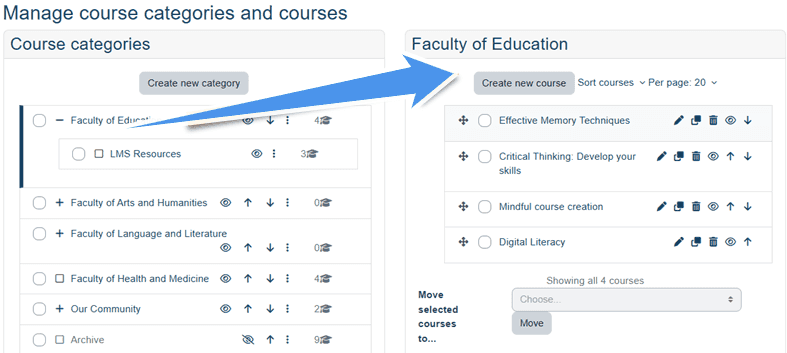
Once your course is uploaded, the course management page opens up a rich toolkit of learning activities. You'll find assignments, quizzes, lessons with adaptive learning features, SCORM modules, workshops, books, glossaries, surveys, H5P content, and numerous other interactive design tools.
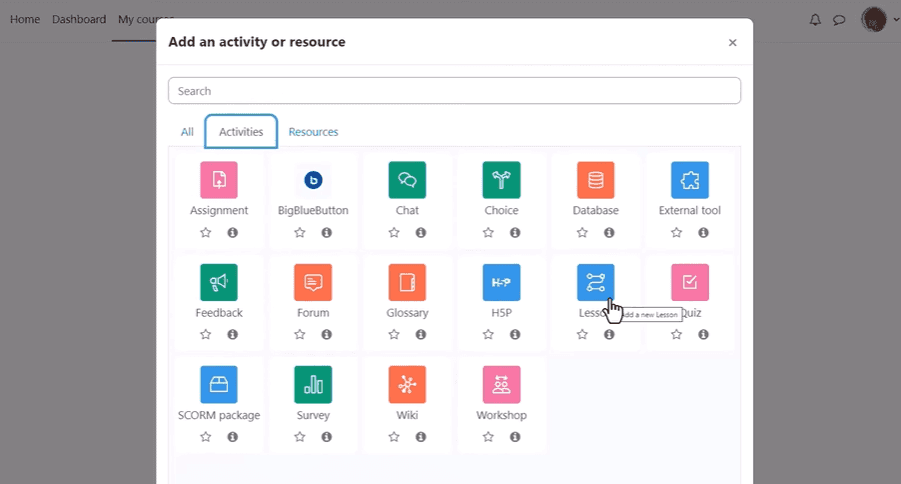
Among the many course creation tools on Moodle, you’d spend the most time on the Rich Text Editor. It serves as the primary content creation tool and is similar to word processors like Microsoft Word. With the Rich Text Editor, you can create tables and lists, format text, insert emojis, upload images, and embed videos into your course.
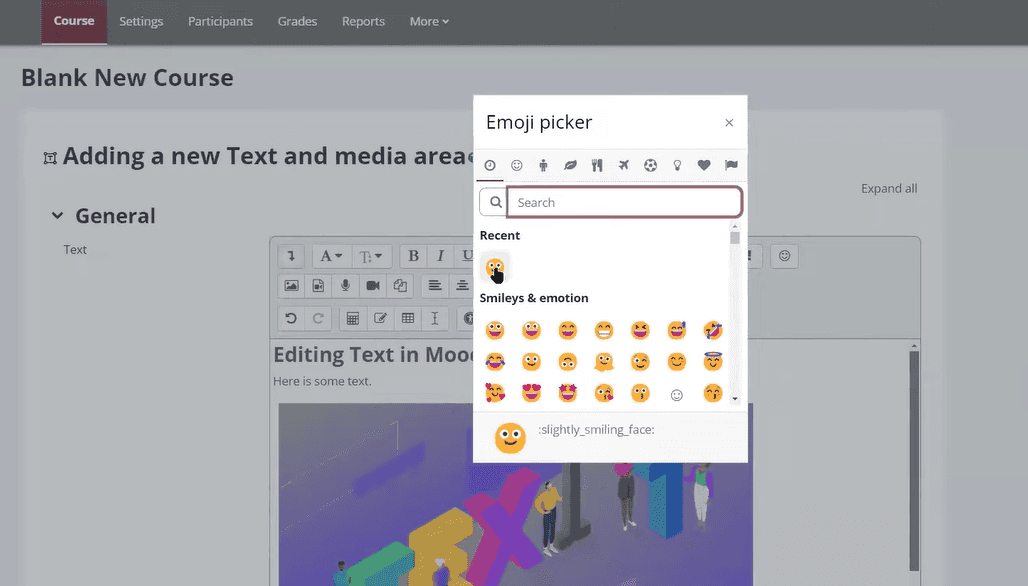
The Rich Text Editor is not listed as an activity or resource on Moodle, but typically appears in all places where you’re editing text, like when adding a new activity, updating section descriptions, or creating quiz questions.
Speaking of quizzes, Moodle’s Quiz activity page is another major area where you will spend a lot of time. It offers multiple question types for formal assessments and take-home evaluations. Plus, a flexible Question bank with granular controls for storing and reusing questions across courses.
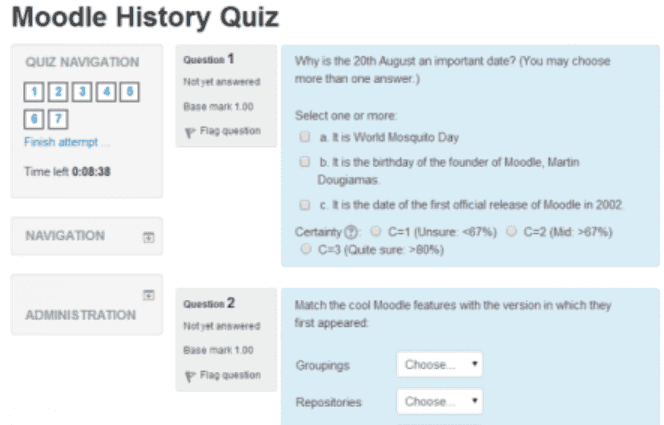
However, it's important to understand that Moodle's quiz system prioritizes post-assessment grading and reflection over real-time engagement. This means that while it’s excellent for exams and homework, it's less effective for live classroom interaction or real-time student engagement.
You can enhance the real-time engagement capabilities of Moodle's quiz system by integrating Wooclap directly into your courses. This adds live polling, instant feedback tools, and advanced question types like Judgment concordance and Framework questions that promote critical thinking during lectures.
Finally, to tie everything together, Moodle provides a customizable Dashboard you can optimize for an at-a-glance overview of all major course activities within your Course pages.
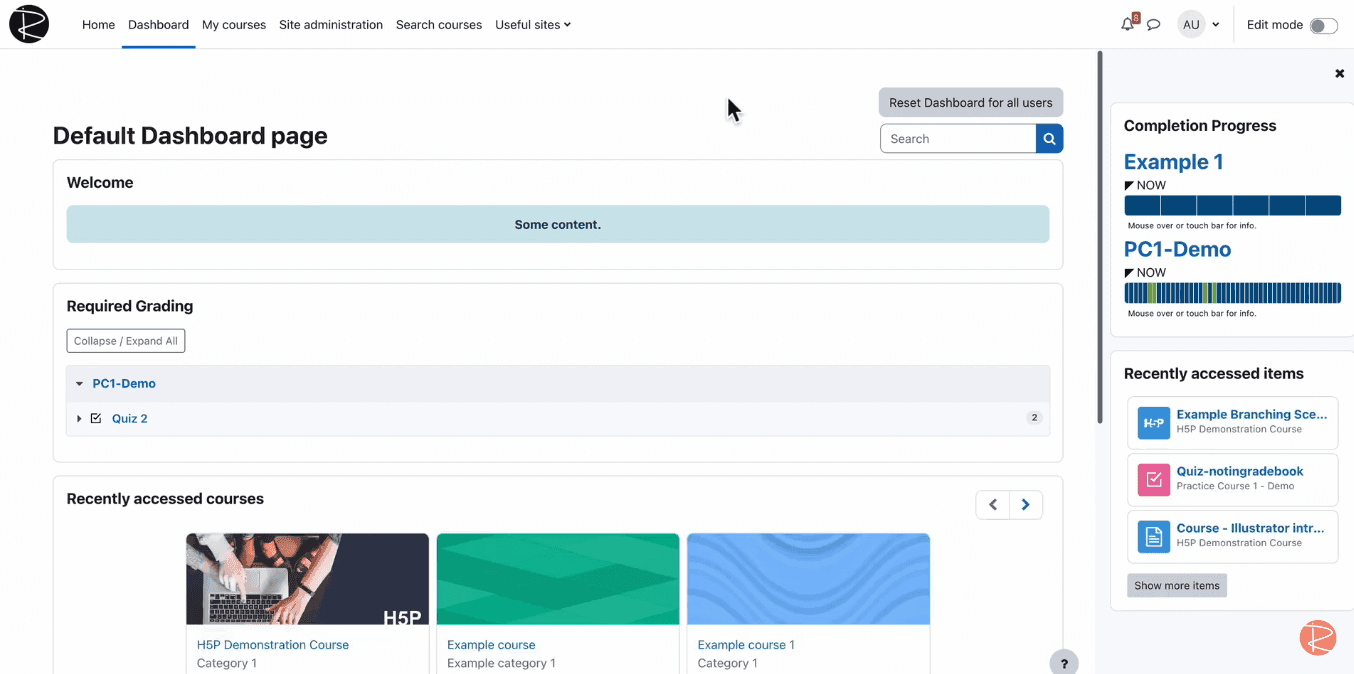
The Dashboard is packed with drag-and-drop block elements you can use to track student progress, create course summaries, check students’ online status, create discussion forums, check course completions, and lots more.
Moodle’s user experience is not that great out of the box; it requires a lot of customization to make it usable to modern web standards. Some of the navigations are confusing, and there are way too many options to grapple with.
Giacomo O., E-learning Manager, G2 Review
Assessment and collaboration tools: Moodle prioritizes the flexibility of third-party plugins and intricate setups over out-of-the-box assessment options, but offers a host of built-in collaboration features for engagement.
| ⭐️⭐️⭐️⭐️ | Limitations Requires significant technical setup. Native Moodle lacks centralized repositories and ePortfolio features. |
Unlike many LMS platforms that offer pre-built assessment tools with built-in guardrails, Moodle takes a more open-ended approach that prioritizes flexibility over simplicity. This philosophy means you'll have robust customization capabilities at your fingertips, but you will have to invest extensively in technical setup and rely on third-party plug-ins.
Take sequential learning paths, for example. While Moodle provides Conditional activities that allow you to create conditional learning journeys based on student performance in an assignment, quiz, or graded discussion, you'll need extensive technical knowledge to effectively configure these pathways.
Similarly, if you need centralized resource sharing or ePortfolio functionality, you'll have to turn to third-party integrations rather than native tools. However, if you’re seeking a more streamlined, out-of-the-box experience, Moodle’s Workplace is a compelling solution.
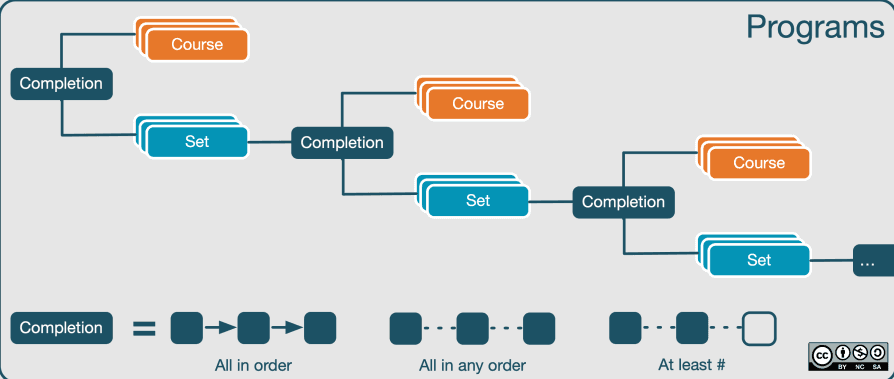
Workplace is Moodle’s enterprise-grade solution designed with native features like custom learning paths, marketplace tools, multi-tenancy support, students’ lifecycle management, centralized repositories, and lots more. But keep in mind that access to the Workplace requires a custom license from a certified Moodle partner, and it is more optimized for corporate environments than educational institutions.
Moodle is one of the most flexible and feature-rich open-source Learning Management Systems available. I love that it allows complete customization - from course structure to user roles, plugin integrations, and UI themes.
Amey D., Business Solutions Specialist, G2 Review
Moving to its collaboration toolkit—the tools you need to boost student engagement and ensure your course modules are duly optimized—Moodle’s standout feature in this area is the Wiki.
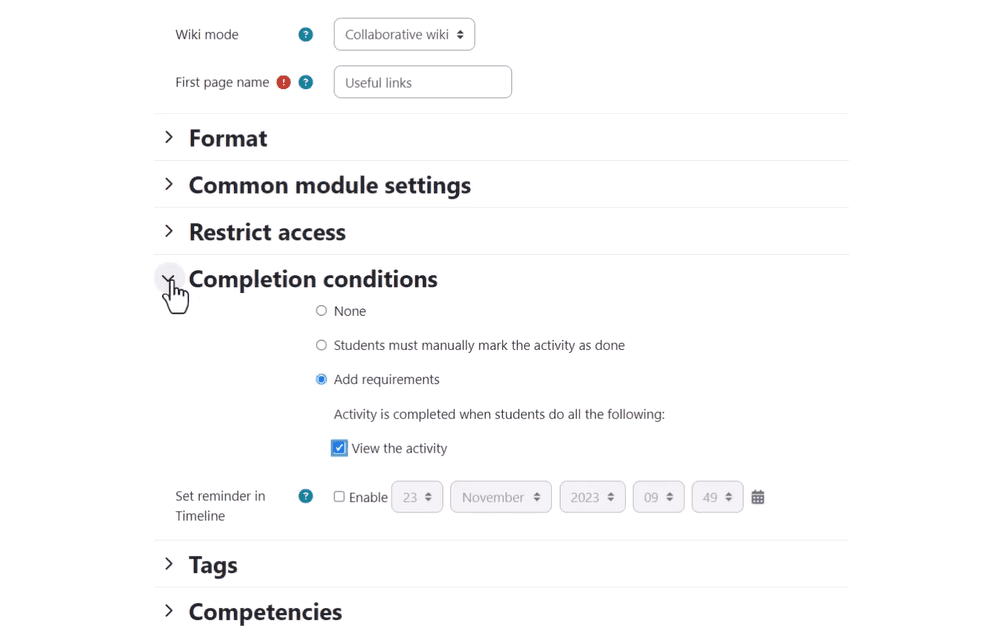
The Wiki is a collaborative learning tool instructors can use to build a course knowledge base, FAQ repository, or study guides. Its strength lies in its completion tracking capabilities, version control, and granular permission settings that give instructors precise control over collaborative projects. But Moodle’s collaborative toolkit extends well beyond the Wiki:
- There’s the Feedback tool for survey creation and administration;
- Announcements forum serving as a dedicated channel for course-wide communications;
- Standard Forums to facilitate threaded conversations;
- A Choice tool that enables quick polls with radio button selections for immediate feedback;
- An Attendance feature that allows instructors and teachers to take attendance during class;
- Blogs tool for tutors and learners who want to create their own blog or register their external blogs;
- An integrated Calendar that provides a centralized view of all course activities;
BigBlueButton activity to create live presentations and host online lessons within a course, and Zoom for other web conferencing activities.
The BigBlueButton web conferencing tool on Moodle is a third-party app that requires a dedicated subscription plan ($7.99-$750/mo). Still, it’s quite limited in the interactive elements it offers. For example, students can’t leave likes, pings, emojis, or raise their hands during a live session without disturbing the ebb and flow of the learning process.
Grading and performance monitoring: Moodle provides a flexible Gradebook with powerful formula-based grade calculations and detailed analytics for tracking student progress and spotting trends.
| ⭐️⭐️⭐️⭐️⭐️ | Limitations Grade calculation flexibility can be complex for instructors unfamiliar with custom formulas. |
When it comes to grading student work, Moodle provides a streamlined grading flow. Its dedicated Gradebook shows you every assignment, quiz, and activity that requires grading.
You can easily view and change grades, sort them however makes sense, highlight and comment directly on student text, record video feedback to give more personal responses, and use marking guides that work like customizable checklists.
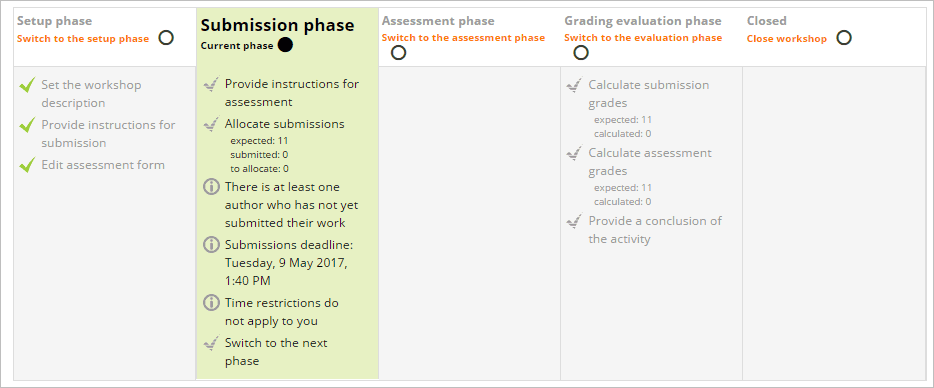
Moodle also provides Workshop activities that let students review each other's work, as well as Rubrics to grade students based on specific criteria you set up ahead of time. You can also plug in Turnitin to check for plagiarism. But where Moodle really gets creative and interesting is with its grade calculation formulas.
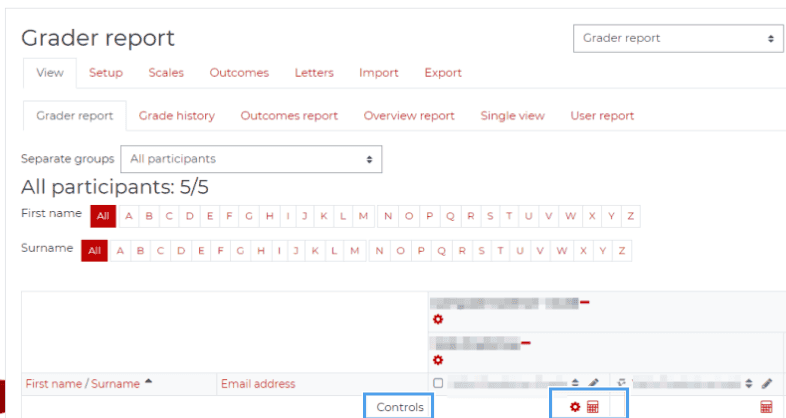
This feature lets you create your own math rules for how final grades get calculated. Instead of being stuck with basic weighted averages, you can write custom formulas that match exactly how you want to grade your course. It's perfect when the standard calculation methods just don't fit your teaching style.
You can extend Moodle's gradebook functionality to sync grades from live learning activities by integrating with Wooclap! The Wooclap Moodle plugin turns interactive activities like multiple-choice questions and polls into graded assignments, which your gradebook automatically picks up and registers without you having to do anything extra.
Moving to Moodle’s performance monitoring tools, the platform provides two main types of reports: Course completion reports to show you the big picture - how students are doing overall in your course. And an Activity report for a deep dive into individual assignments and activities, showing you exactly where students might be struggling or excelling.
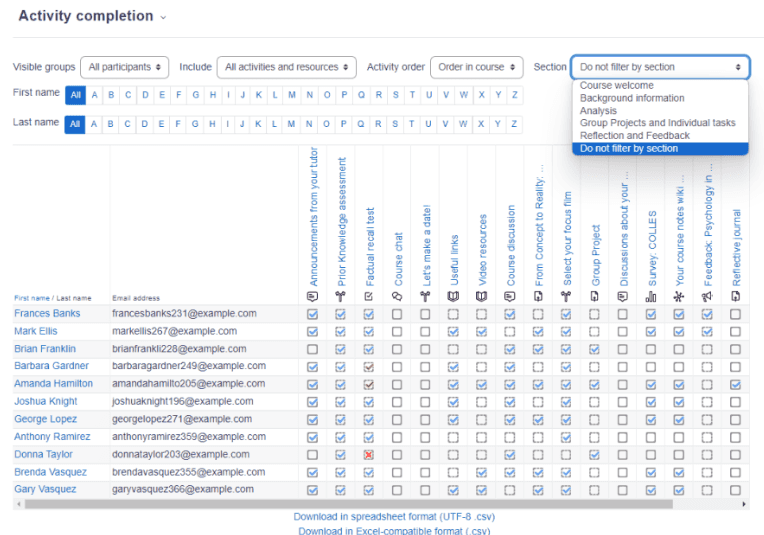
But what we loved most about Moodle’s performance monitoring tools is its learning analytics feature, which works like a smart assistant that's always watching for warning signs and opportunities to help students succeed. Administrators can use it to spot patterns that show when a student is at risk of dropping out or identify teaching methods that aren’t as effective as they could be within their Moodle environments.
Moodle is free and Open Source, so it's great. Also, it's modular and plugin-based, so administrators can use the desired features. I particularly like features to engage students at risk of dropping out.
Ivan A., Lecturer, Capterra Review
Moodle review: Pricing plans & costs
Moodle supports manual self-hosting for institutions that want to manage small projects and handle server-related costs, and cloud-based deployment for institutions that want customized hosting plans to manage millions of users
However, the LMS itself is free and attracts no licensing cost. Except if you want the enhanced workplace version. The pricing options for its cloud-based deployment include:
- Starter plan priced at $130 for 50 users
- Mini plan priced at $230 for 100 users
- Small plan priced at $410 for 200 users
- Medium plan priced at $950 for 500 users
- Standard plan priced at $1,790 for 750 users
Keep in mind that all plans are billed annually in Australian Dollars (AUD) and offer the same features, with the flexibility to upgrade or downsize the number of users and file storage you pay for.
Moodle review: What are users saying
After analyzing multiple Moodle reviews across Capterra, G2, and Trustpilot, we found that Moodle averages between 2.2 and 4.3 stars. Sentiments range widely based on user expectations, with its highly flexible and customizable architecture being the most common theme of praise.
What users love about Moodle
💕 Highly programmable
“...It is highly programmable, meaning that if you know coding, you can make it work well for you...”
Dale H., Online Learning Consultant
💕 Run smooth online classes
“...makes it easy to manage online student attendance, exams, results published, etc...”
Vinay Prakash, Project manager
💕 Seamless third-party integration
“...Provides a web service API that makes integration with other systems seamless..."
Simbarashe Z., Systems Administrator
What users don't like about Moodle
👎 Steep learning curve
“...while customizable and flexible, Moodle is still quite complex for new users, and requires a learning curve...”
Muhammad Naveed, Assistant Director IT
👎 Outdated interface
“...it needs a more modern-looking interface as it appears a bit dated...”
Babajide I., English teacher
👎 Slow performance speed
“...with a lot of students using quizzes at the same time, I constantly met slow loading and time out...”
Abdullah J., Senior professor
Moodle review: Pros & cons
 | |
| Moodle Pros | Moodle Cons |
✅ Drag-and-drop blocks | ❌ Steep learning curve |
✅ Flexible collaboration tools | ❌ Slow performance speed |
✅ Powerful gradebook | ❌ Limited built-in tools |
✅ Extensive plugin directory | ❌ Frequent software bugs |
✅ Predictive learning analytics | |
✅ Fully open-source and self-hostable | |
Top Moodle integration: Wooclap
At this point, it's clear that Moodle is a solid LMS for institutions that want to create rich, personalized learning environments that align with their unique goals and teaching styles. But let’s be honest — it’s not built to spark live, in-the-moment engagement. And that’s why we included Wooclap in this review.
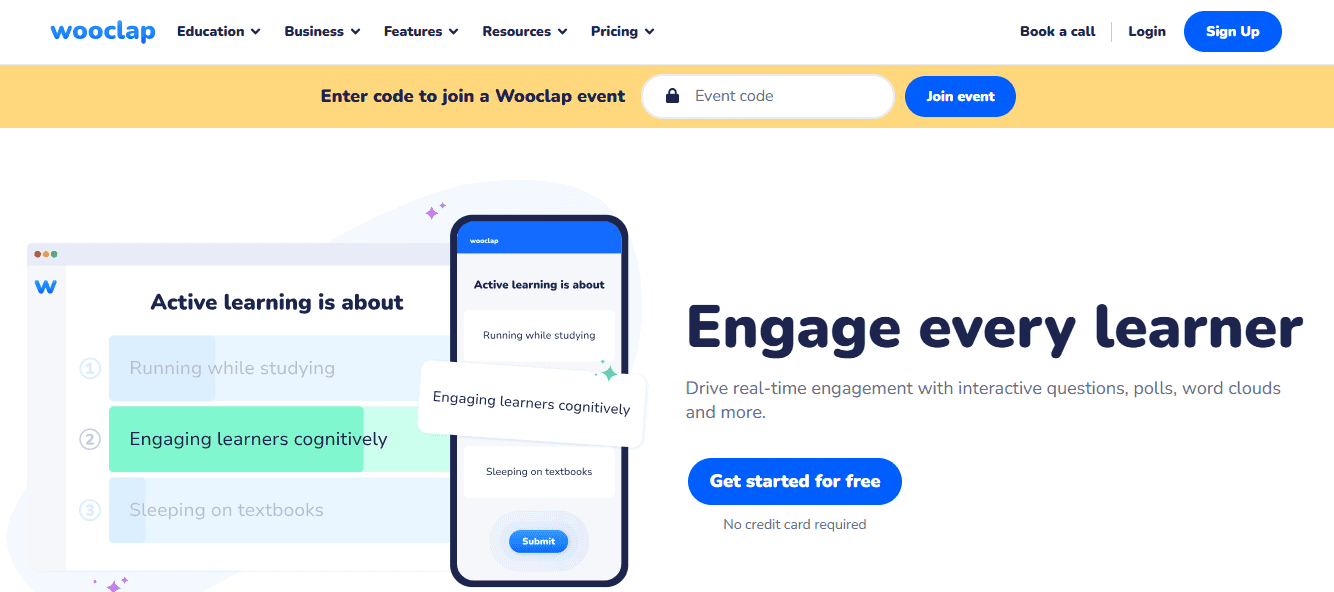
Integrating Wooclap with Moodle means you keep Moodle’s robust course management system while adding real-time polls, quizzes, and interactive questions that turn passive listeners into eager participants. Below is an overview of how Wooclap transforms your Moodle experience.
1. Works right inside Moodle
Forget about juggling multiple apps and making students remember different passwords. Wooclap plugs directly into Moodle's course creation page, so you can add interactive polls and quizzes without leaving your familiar workspace. Students just click and participate, no extra steps, no confusion.
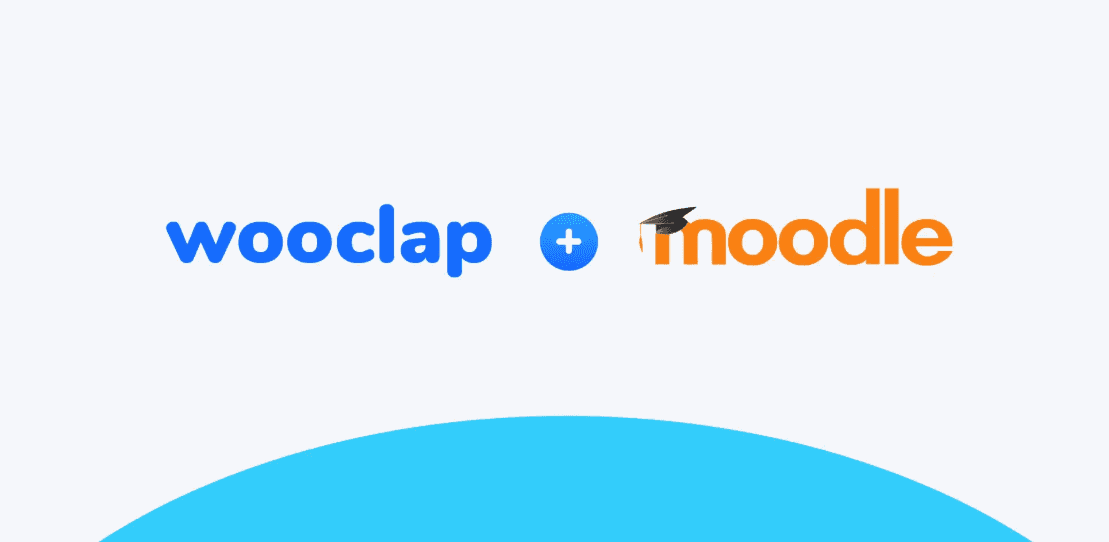
2. Provides real-time feedback during live sessions
Remember how we mentioned Moodle's quiz system is great for grading, but not so much for live engagement? Wooclap fixes that. You can launch instant polls, collect anonymous questions through the message wall, and see likes, pings, emojis, or raised hands from students who are confused in real-time without having to ask.
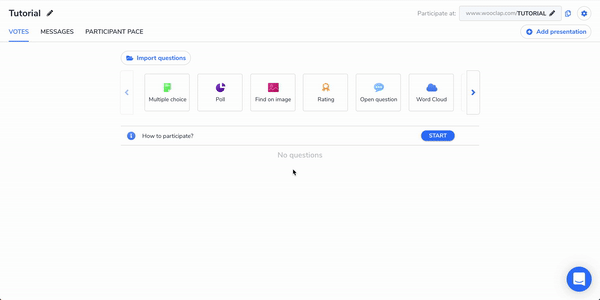
3. Grades sync automatically
Wooclap + Moodle integration means less manual work. It automatically sends participation scores and quiz results straight to your Moodle gradebook with one click. No spreadsheets or duplicated data entries, just smooth automatic grading.
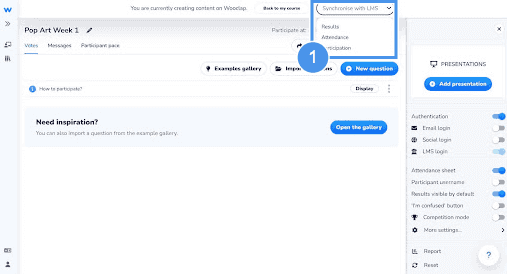
4. Shows you each student’s engagement level
Wooclap's analytics not only tell you who got what right, but they also show you who's actively participating, who's struggling to keep up, and which parts of your lesson are making the greatest impact. Plus, you can also customize and send these engagement reports to students.
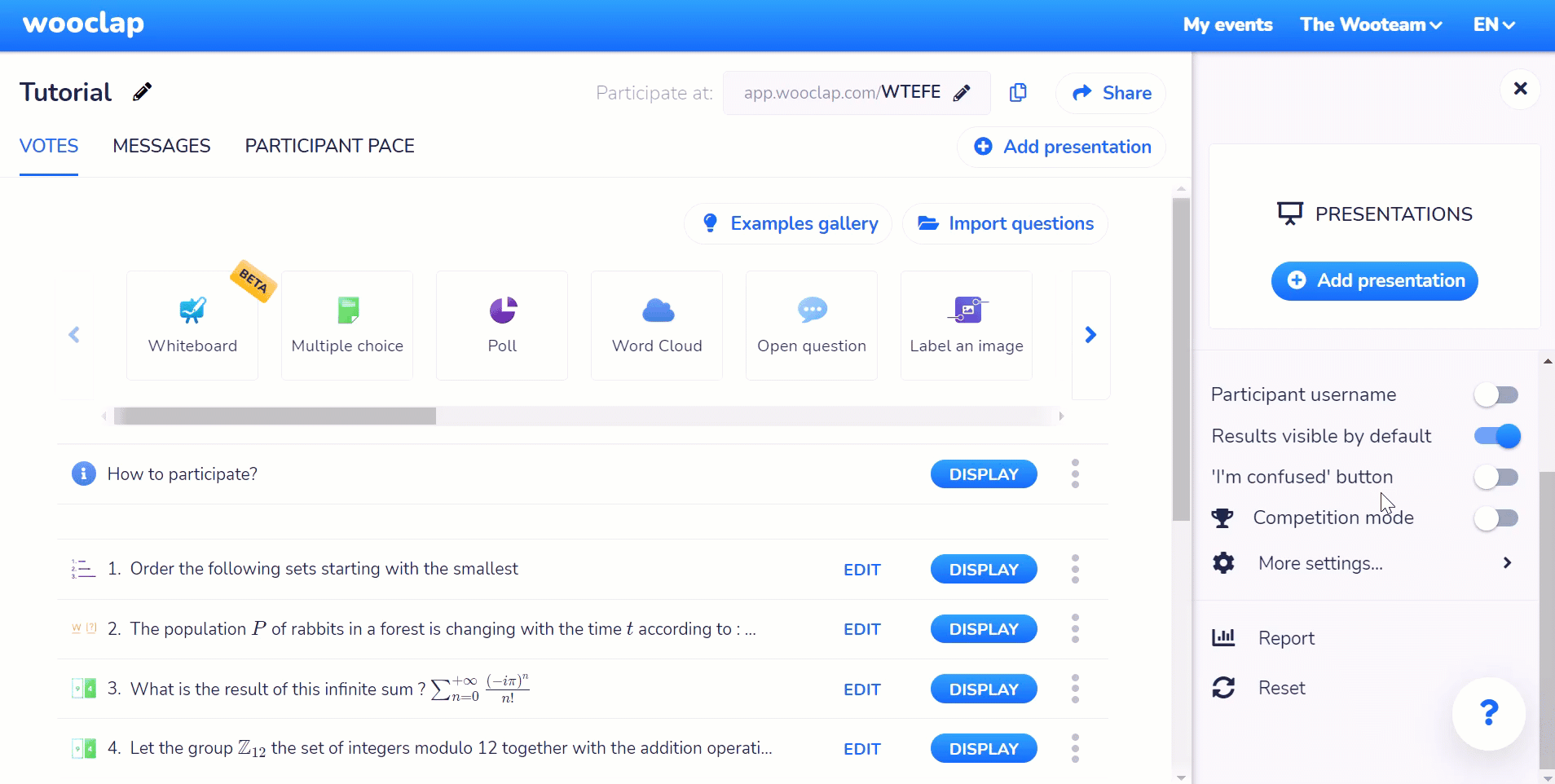
5. Pricing that makes sense
Unlike other tools that surprise you with hidden costs, Wooclap keeps it simple. There’s an entirely free plan that you can plug into your Moodle instance to learn the ropes. And educational plans that start at $7.99/user/month for basic features and $14.99/month for full access. It also supports custom packages for institutions that prioritize campus-wide integration.
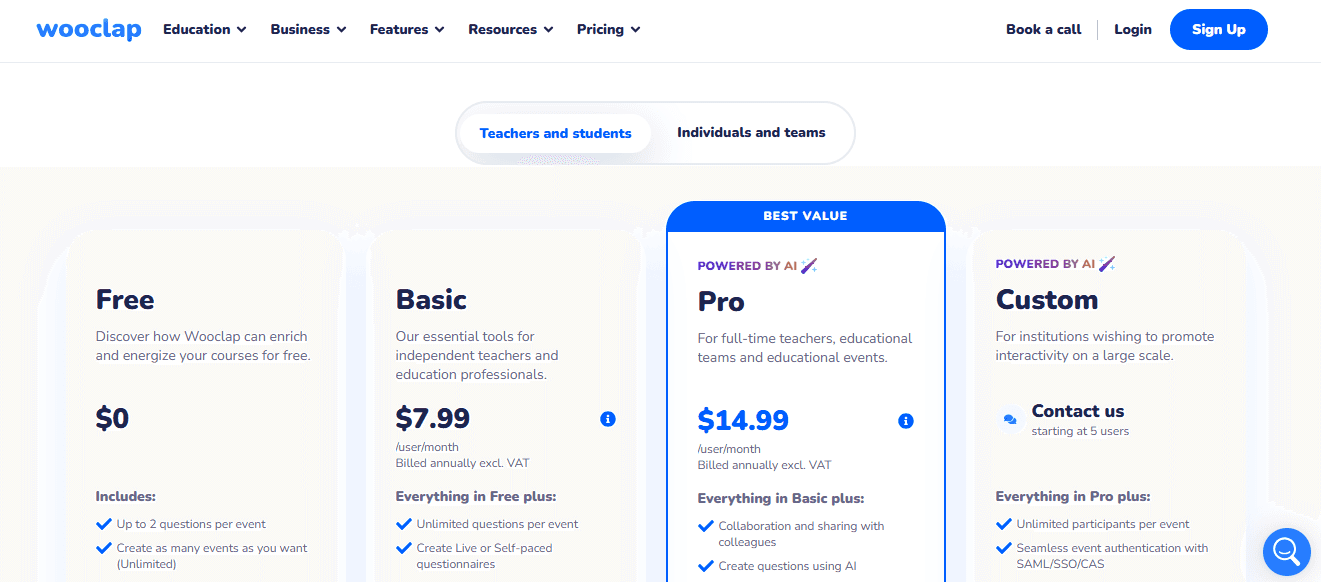
Top Moodle integration: What are users saying about Wooclap
Now that you understand why the Wooclap Moodle plugin is crucial, let’s look into verified reviews from real-life Wooclap users to learn how well it fits. But before we dive in, know that Wooclap consistently earned a 4.4 to 4.6 rating across G2, Capterra, and Trustpilot.
What users love about Wooclap
💕 Fantastic learning tool
“If you are looking to spice up some in-class or virtual training, Wooclap is a fantastic way to make this happen!”
Troy D., VP. Operations, Education Management
💕 Accommodates shy students
“I love the fact that Wooclap allows shy students to contribute, not just a handful of confident people...”
Debora C., Tutor for TaLIC
💕 Personalized reports
“Simple collaborative tool with very useful reports for keeping track of completed work and sending it to learners...”
Ghislaine B., Professional Training & Coaching
💕 Easy integration
“Easy integration with PowerPoint, Zoom, MS Teams, Google Slides, and Moodle LMS....”
Verified Reviewer, Computer science lecturer
💕 Top Notch Support
“...Customer service representatives are always available and very attentive to needs."
Agathe L., Training consultant and coach
Still in Doubt? Try Wooclap Risk-Free!
Wooclap offers a free plan with up to 1,000 participants and two questions per event, letting you test its core features for free. But if you insist, Wooclap offers a 30-day money-back guarantee on its annual subscriptions, giving you ample time to explore its full potential.
Moodle + Wooclap: Frequently asked questions
When you combine Moodle's course management with Wooclap's interactive features, you create a learning environment where structured courses meet real-time engagement. So we understand that you might have a few concerns about how this integration works in practice.
Do I need a separate Wooclap account to use the Moodle plugin?
It depends! As an instructor, you need a Wooclap account to effectively install the plugin into your Moodle courses, but students don’t need to create separate Wooclap accounts to use the plugin. Student’s authentication is handled directly via Moodle, and access to Wooclap is seamless through the course interface. Plus, when students participate in Wooclap activities through the Moodle site, they're automatically identified using their Moodle credentials.
Can I use the Wooclap Moodle plugin to promote critical thinking and in-depth analysis in real-time?
Yes! In addition to the plethora of quizzes and polls Wooclap adds to your Moodle instance, it provides a Judgment concordance question type, a Framework feature, and a Prioritization question format for ranking ideas and insights. These are especially useful for managing cohesive learning experiences like SWOT analysis or McKinsey's 7S, where concepts narratively build upon each other.
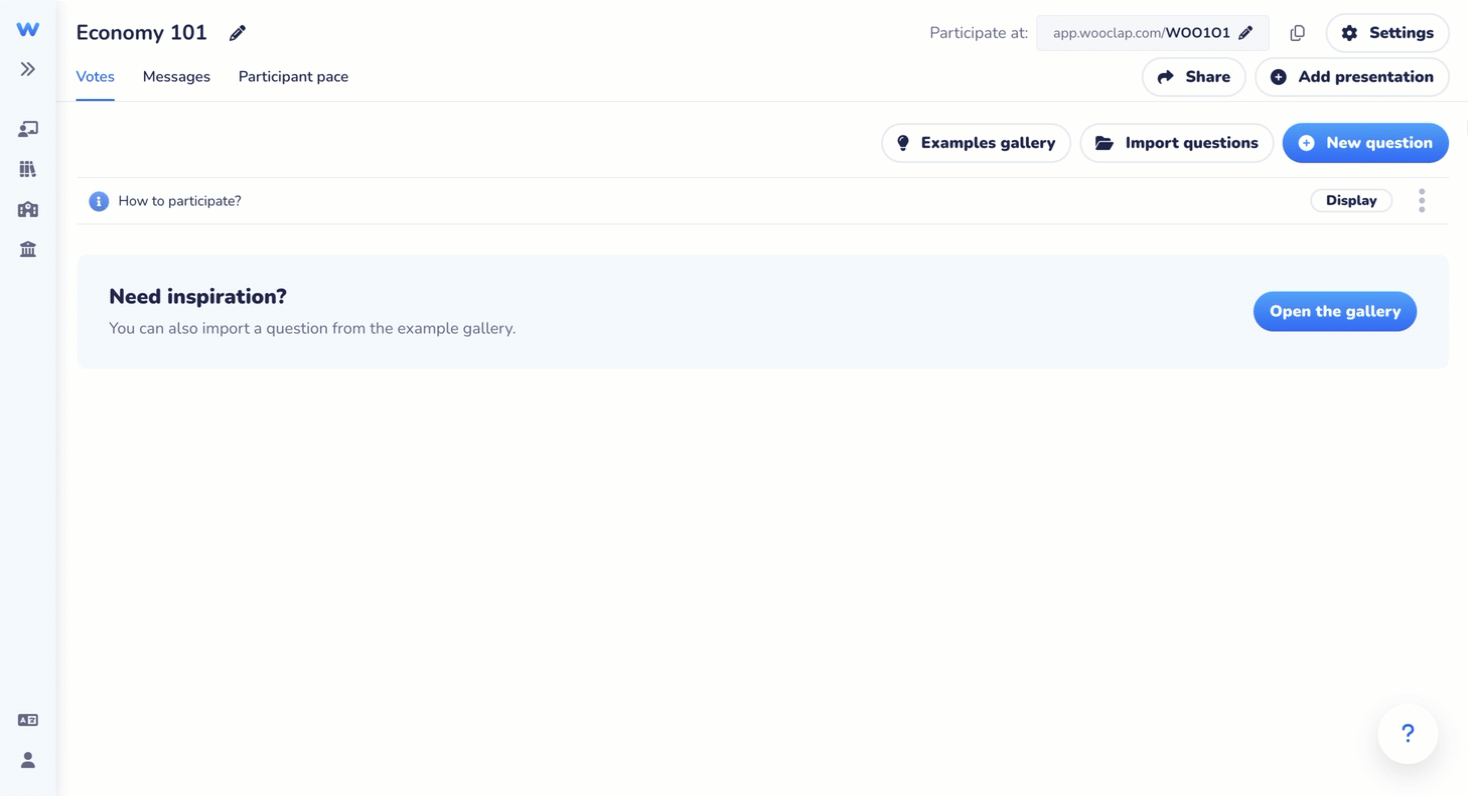
Can I move questions from Moodle to Wooclap?
Yes, all Moodle question types are supported on Wooclap and vice versa. To move questions from your Moodle question bank to Wooclap, you will need to export Moodle questions to Moodle XML format. Then click on Import event from your Wooclap account, choose From Moodle, and select the file you previously exported.
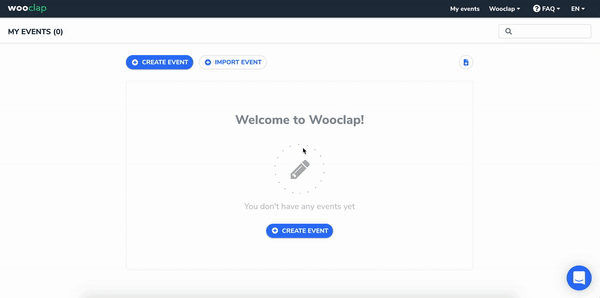
Is the Moodle plugin available for both free and paid plans?
Yes, the Wooclap Moodle plugin is accessible by users on both free and paid plans. However, with certain limitations. Advanced features like analytics or advanced question types depend on your Wooclap subscription level.
Moodle + Wooclap: Final verdict
Moodle lays the foundation for delivering structured, trackable, and richly organized learning experiences. It’s the backbone you need for managing entire courses, assessments, grades, and long-term learning journeys. Use Moodle if:
- You want a complete LMS to design, deliver, and track courses
- You need robust grading, certifications, and learner progress reports
- You’re running formal programs in higher education or professional development
- You require customizable workflows and integrations for large-scale training
Wooclap, meanwhile, enhances your Moodle courses with interactive elements optimized to drive engagement and deepen understanding. Integrated directly into Moodle, it makes live sessions and asynchronous content more participatory. Use Wooclap if:
- You want to embed critical thinking and cohesive learning features into Moodle lessons
- You’re aiming for instant feedback and two-way interaction—whether in person or online
- You want to surface learner misunderstandings in real time to adjust your teaching
- You’re looking for powerful engagement data that complements Moodle’s gradebook
Writer

The Wooclap team
Make learning awesome & effective
Subject
A monthly summary of our product updates and our latest published content, directly in your inbox.
